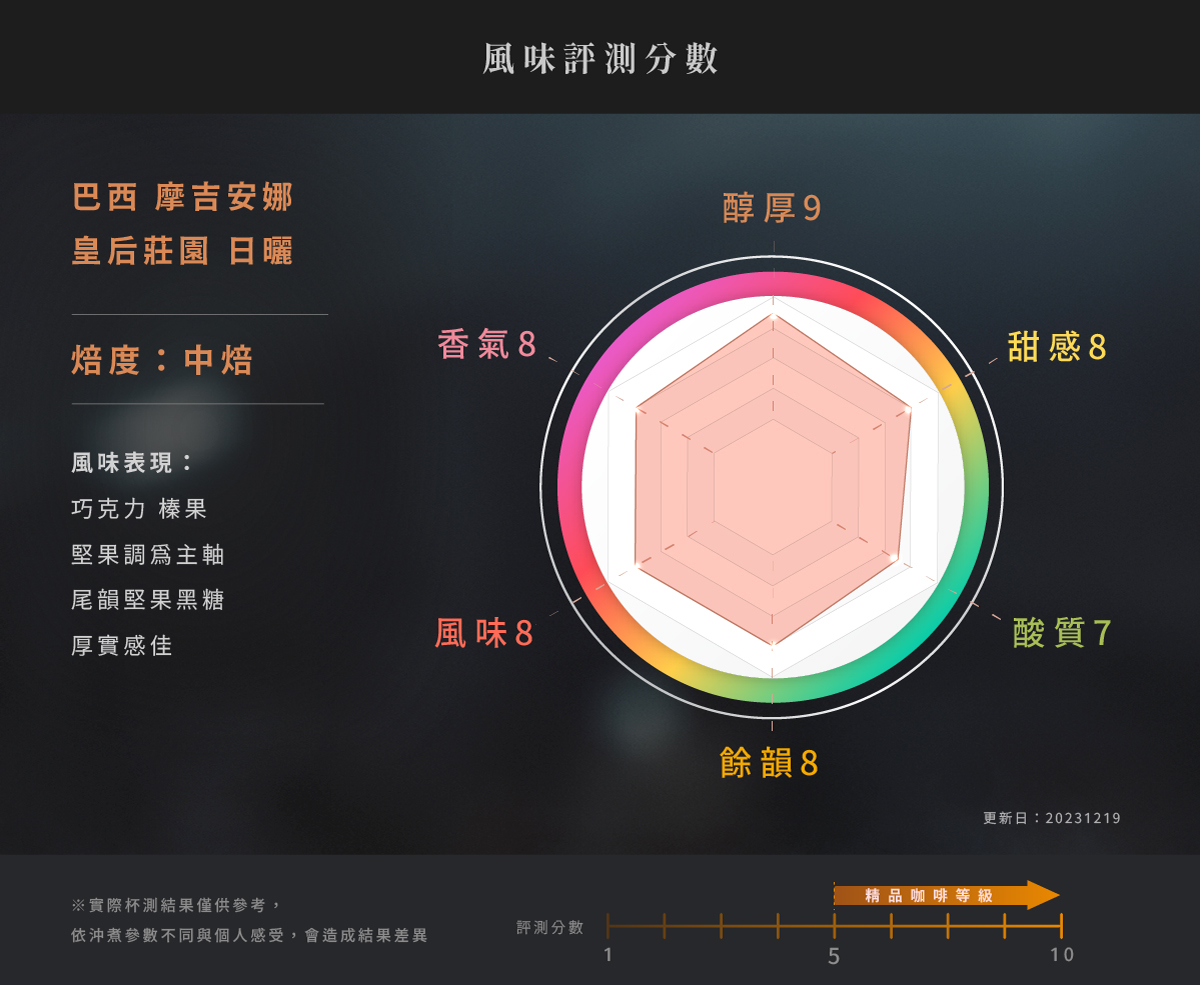

Coffee Bean Origin: Brazil Single Estate/Cooperative. There are processing methods available for selection.
Brazil São Paulo Alta Mogiana Sugar Roll Pulped Natural

-----
Brazil Mogiana Rainha Farm Natural









Coffee Flavor
The flavors of coffee are derived from the breakdown of various nutrients in the green coffee beans during roasting. Heat causes these compounds to degrade into a variety of aromatic molecular structures, resulting in a wide spectrum of flavors. High-quality coffee beans naturally possess a rich aroma that evolves at different temperatures—high, medium, and low—offering a delightful and nuanced experience worth savoring.
Brazil São Paulo Alta Mogiana Sugar Roll Pulped Natural
Cheese, raw cacao, macadamia nut, butter, brown sugar, sweet and smooth.
Brazil Mogiana Rainha Farm Natural
Chocolate, hazelnut, and nutty forward, with a nutty brown sugar finish and good body.

Brazil is figuratively described as the "giant" and "monarch" of the coffee world because it is the world's largest coffee producer. There are approximately 3.97 billion coffee trees, and smallholder farmers now cultivate coffee that accounts for 75% of Brazil's total national production. The number of people involved in coffee production in Brazil is two to three times that of Colombia, which is the world's third-largest coffee producer. Coffee in Brazil is generally grown in flatter regions. To adapt to the local conditions, Brazilian estate owners decades ago developed improved Arabica coffee trees that do not require high altitudes or shade. These can be planted on plains or grasslands, directly exposed to the bright sun, which is different from the traditional shade-grown cultivation method at higher altitudes.
The Mogiana region of Brazil, along with Cerrado and Sul de Minas, is considered one of Brazil's three major specialty coffee regions. Because the coffee trees grow in rainforest land, the flavor is comfortably mellow and smooth, unlike the pronounced fruit acidity of typical high-altitude coffees.
Rainha Farm has high recognition in Brazil and is owned by the Carvalho Dias family. The four estates under Carvalho Dias have won awards every year since the first Brazilian Cup of Excellence (COE) competition in 1999, achieving over 12 wins in 7 years. In 2004, they even swept the top positions, taking 1st, 9th, and 11th place. Finca La Esmeralda itself boasts a remarkable record: 2nd place in 2000, 3rd place in 2001, and 1st place in 2011. The meticulousness and dedication in the processing methods at Finca La Esmeralda are key to its exceptional quality.

The Arabica coffee variety Bourbon
The Arabica coffee variety Bourbon is currently one of the closest to the native species and is found in Reunion (originally named Bourbon) off the island of Madagascar. Bourbon has its own characteristics and has the same high-quality taste as Typica, with a sour taste like red wine and a sweet aftertaste. Tiberica and Bourbon can be distinguished from the leaves and bean appearance of the coffee tree. The leaves of Bourbon are wider, and the coffee cherries are smaller and denser, so the appearance of the beans is smaller and rounder than Tiberica. In Kenya and Tanzania, Bourbon progeny was used to artificially mix, and "SL28" and "SL34" artificial new varieties appeared, which are famous for their good flavor performance. Although the yield of bourbon is higher than Typica, the harvest period is also 2 years, and it can be regarded as a variety with less output.
The Arabica coffee variety Catuai
Catuai, the Arabica coffee variety, is a hybrid of Caturra and Mundo novo. Caturra is short and Mundo Novo is tall. Later, the improved height is more convenient for harvesting. The taste is sweet, the sweetness performance is similar to that of Cattura, and the sourness is less, which improves the shortcomings of bad taste and poor flavor, and has a good sense of balance.

(Coffee Processes)
The term "processing methods" refers to the process of transforming ripe red coffee cherries into dried green beans. Each method has its advantages and disadvantages, influenced by the natural environment and the specific needs of the coffee-producing region. As a result, different regions adopt the processing method most suited to their conditions. This batch uses the following pulped natural methods, described below:
【Pulped Natural】
This is a method of processing green coffee beans in Brazil. A pulping machine removes the outer skin and a portion of the mucilage layer. The beans are then placed under the sun to dry. This is similar to the Yellow Honey process, where "honey" refers to the sticky mucilage layer, with a stickiness akin to honey. The mucilage layer retains a high proportion of sugars and acids, and with proper fermentation control, this process enhances flavor and sweetness.





JUSTIN INTERNATIONAL FOOD ENTERPRISE CO., LTD.
Tel: +886-3-358-6611
1st Floor, No. 30, Lane 120, Daxing Road, Taoyuan District, Taoyuan City
▶This product is covered by a NT$10 million product liability insurance.
▶Food Industry Registration Number: F-165601955-00000-0
▶ Our company’s cupper is certified as a CQI International Coffee Quality Appraiser.



Recommended Products



